Paleoenvironmental Changes for the Last 3000 Cal Years BP in the Pueyrredón Lake Basin, Southern Patagonia, Argentina
Abstract
1. Introduction
1.1. Environmental Characteristics and Vegetation of the Pueyrredón Lake Area
1.2. Previous Paleo-Environmental Investigations
2. Materials and Methods
2.1. Study Site
2.2. Sedimentological Analysis
2.3. Chronological Data
2.4. Pollen Analysis
3. Results
3.1. Modern Pollen Data
3.2. Stratigraphy of Fossil Record
3.3. Fossil Pollen Record
3.3.1. Zorro Bayo Sequence
3.3.2. Archaeological Site COCU
4. Discussion
4.1. Modern Pollen Representation
4.2. Vegetation Dynamics of the Last 3000 Cal Years BP
4.3. Regional Integration
5. Conclusions
Author Contributions
Funding
Data Availability Statement
Acknowledgments
Conflicts of Interest
References
- Garreaud, R.D.; Lopez, P.; Minvielle, M.; Rojas, M. Large Scale Control on the Patagonia Climate. J. Clim. 2013, 26, 215–230. [Google Scholar] [CrossRef]
- Moy, C.M.; Moreno, P.I.; Dunbar, R.B.; Kaplan, M.R.; Francois, J.-P.; Villalba, R.; Haberzettl, T. Climate Change in Southern South America during the Last Two Millennia. In Past Climate Variability in South America and Surrounding Regions; Vimeux, F., Sylvestre, F., Khodri, M., Eds.; Springer: Berlin/Heidelberg, Germany, 2009; Volume 14, pp. 353–393. [Google Scholar]
- Paruelo, J.M.; Jobbágy, E.G.; Sala, O.E. Biozones of patagonia (Argentina). Ecol. Austral 1998, 8, 145–153. [Google Scholar]
- Fletcher, M.S.; Moreno, P.I. Zonally symmetric changes in the strength and position of the Southern Westerlies drove atmospheric CO2 variations over the past 14 k.y. Geology 2011, 39, 419–422. [Google Scholar] [CrossRef]
- Lamy, F.; Kilian, R.; Arz, H.W.; Francois, J.P.; Kaiser, J.; Prange, M.; Steinke, T. Holocene changes in the position and intensity of southern westerly wind belt. Nat. Geosci. 2010, 3, 695–699. [Google Scholar] [CrossRef]
- Mayr, C.; Wille, M.; Haberzettl, T.; Fey, M.; Jansen, S.; Lücke, A.; Ohlendorf, C.; Oliva, G.; Schäbitz, F.; Scleser, G.H.; et al. Holocene variability of the Southern Hemisphere westerlies in Argentinean Patagonia (52° S). Quat. Sci. Rev. 2007, 26, 579–584. [Google Scholar] [CrossRef]
- Varma, V.; Prange, M.; Lamy, F.; Merkel, U.; Schulz, M. Solar-forced shifts of the Southern Hemisphere Westerlies during the late Holocene. Clim. Past Discuss 2010, 6, 369–384. [Google Scholar]
- Villa-Martínez, R.; Moreno, P.I.; Valenzuela, M.A. Deglacial and postglacial vegetation changes on the Eastern slopes of the central Patagonian Andes (47° S). Quat. Sci. Rev. 2012, 32, 86–99. [Google Scholar] [CrossRef]
- Echeverría, M.E.; Bamonte, F.P.; Marcos, M.A.; Sottile, G.D.; Mancini, M.V. Past vegetation reconstruction maps and paleoclimatic variability inferred by pollen records in southern Patagonia Argentina since the Late Glacial-Holocene transition. J. S. Am. Earth Sci. 2022, 116, 103834. [Google Scholar] [CrossRef]
- Haberzettl, T.; Wille, M.; Fey, M.; Janssen, S.; Lucke, A.; Mayr, C.; Ohlendorf, C.; Schäbitz, F.; Schleser, G.H.; Zolitschka, B. Environmental change and fire history of southern Patagonia (Argentina) during the last five centuries. Quat. Int. 2006, 158, 72–82. [Google Scholar] [CrossRef]
- Heusser, C.J. Ice Age Southern Andes: A Chronicle of Paleoecological Events. Developments in Quaternary Science, 3rd ed.; Elsevier: Amsterdam, The Netherlands, 2003; p. 240. [Google Scholar]
- Mancini, M.; Bamonte, F.; Marcos, M.; Sottile, G.; Echeverría, M. Análisis y métodos paleoecológicos para la reconstrucción de comunidades de bosque y estepas de Patagonia, Argentina. Publicación Electrónica Asoc. Paleontológica Argent. 2018, 18, 77–101. [Google Scholar] [CrossRef]
- Markgraf, V. Paleoenvironments and paleoclimates in Tierra del Fuego and southermost Patagonia, South America. Palaeogeog. Palaeoclimatol. Palaeoecol. 1993, 102, 53–68. [Google Scholar] [CrossRef]
- Wille, M.; Schäbitz, F. Late-glacial and Holocene climate dynamics at the steppe/forest ecotone in southernmost Patagonia, Argentina: The pollen record from a fen near Brazo Sur, Lago Argentino. Veget. Hist Archaeobot. 2009, 18, 225–234. [Google Scholar] [CrossRef]
- Sottile, G.D.; Echeverría, M.E.; Tonello, M.S.; Marcos, M.A.; Bamonte, F.P.; Rayó, C.; Mancini, M.V. Dinámica de la vegetación andina del lago Argentino (50°S, 72°O) desde el retiro de los glaciares (ca. 12.000 años cal AP). Andean. Geol. 2020, 47, 599–627. [Google Scholar] [CrossRef]
- Echeverría, M.E.; Sottile, G.D.; Mancini, M.V.; Fontana, S.L. Nothofagus forest dynamics and palaeoenvironmental variations during the mid and late Holocene, in southwest Patagonia. Holocene 2014, 24, 957–969. [Google Scholar] [CrossRef]
- Mancini, M.V. Holocene vegetation and climate changes from a peat pollen record of the forest-steppe ecotone, Southwest of Patagonia (Argentina). Quat. Sci. Rev. 2009, 28, 1490–1497. [Google Scholar] [CrossRef]
- Bamonte, F.P.; Mancini, M.V. Palaeoenvironmental changes since Pleistocene-Holocene transition: Pollen analysis from a wetland in Southwestern Patagonia (Argentina). Rev. Palaeobot. Palynol. 2011, 165, 103–110. [Google Scholar] [CrossRef]
- Bamonte, F.P.; Mancini, M.V.; Sottile, G.D.; Marcos, M.A.; Gogorza, C.S.G. Vegetation dynamics from Lago San Martín area (Southwest Patagonia, Argentina) during the last 6500 cal BP. Veg. Hist. Archaeobot. 2015, 24, 267–277. [Google Scholar] [CrossRef]
- Mosquera, B.; Mancini, M.V. Paleoenvironmental analysis of wet meadow in the Deseado Massif: Implications for the Holocene occupation of Argentinian Patagonia. Holocene 2021, 31, 1609–1620. [Google Scholar] [CrossRef]
- McCulloch, R.D.; Figuerero Torres, M.J.; Mengoni Goñalons, G.L.; Barclay, R.; Mansilla, C. A Holocene record of environmental change from Río Zeballos, central Patagonia. Holocene 2017, 27, 941–950. [Google Scholar] [CrossRef]
- Marcos, M.A.; Bamonte, F.P.; Echeverria, M.E.; Mancini, M.V. Southern Patagonian archaeological sites (47°–49° S; 72° W, Argentina) as pollen Records: Pollen Preservation Analysis Considerations for Accurate Palaeoenvironmental Reconstructions. J. Anthropol. Archaeol. Sci. 2020, 2, 205–219. [Google Scholar]
- Marcos, M.A.; Bamonte, F.P.; Mancini, M.V. Utilización de los datos polínicos en sitios arqueológicos de Patagonia: Metodologías estadísticas, alcances y límites interpretativos. Comechingonia 2020, 24, 105–136, ISSN 0326-7911. [Google Scholar]
- Marcos, M.A.; Bamonte, F.P.; Echeverría, M.E.; Sottile, G.D.; Mancini, M.V. Changes in vegetation and human-environment interactions during the Holocene in the Lake Pueyrredón area (Southern Patagonia). Veget. Hist. Archaeobot. 2022, 31, 291–305. [Google Scholar] [CrossRef]
- Horta, L.R.; Georgieff, S.M.; Console Gonella, C.A.; Busnelli, J.; Aschero, C.A. Registros de fluctuaciones paleobatimétricos del sistema lacustre Pueyrredón-Posadas-salitroso durante el Pleistoceno tardío? Holoceno temprano, noroeste de Santa Cruz, Argentina. Ser. Correlación Geológica 2011, 27, 100–109. [Google Scholar]
- Horta, L.R.; Marcos, M.A.; Bozzuto, D.L.; Mancini, M.V.; Sacchi, M. Paleogeographic and paleoenviromental variations of Pueyrredón Lake Posadas—Salitroso area during the Holocene and their relationship to occupational dynamics. Palaeogeog. Palaeoclim. Palaeoecol. 2016, 449, 541–552. [Google Scholar] [CrossRef]
- Horta, L.R.; Marcos, M.A.; Sacchi, M.; Bozzuto, D.L.; Georgieff, S.M.; Mancini, M.V.; Civalero, M.T. Paleogeographic and paleoenvironmental evolution in northwestern Santa Cruz (Argentina), and its influence on human occupation dynamics during the late Pleistocene- early Holocene. Palaeogeog. Palaeoclimatol. Palaeoecol. 2019, 516, 44–53. [Google Scholar] [CrossRef]
- Aschero, C.; Bozzuto, D.; Civalero, T.; De Nigris, M.; di Vruno, A.; Dolce, V.; Fernández, N.; González, L.; Sacchi, M. Nuevas evidencias sobre las ocupaciones tempranas en Cerro Casa de Piedra 7. In Arqueología de Fuego-Patagonia. Levantando Piedras, Desenterrando Huesosy Develando Arcanos; Morello, F., Martinic, M., Prieto, A., Bahamonde, G., Eds.; Ediciones CEQUA: Punta Arenas, Chile, 2002; pp. 569–576. [Google Scholar]
- Aschero, C.; Bozzuto, D.; Civalero, T.; De Nigris, M.; di Vruno, A.; Dolce, V.; Fernández, N.; González, L.; Limbrunner, P. El registro arqueológico de la costa noroeste del Lago Pueyrredón-Cochrane (Santa Cruz, Argentina). In Arqueología de Patagonia: Una Mirada Desde el Último Confín; Salemme, M., Santiago, F., Alvarez, M., Piana, E., Vazquez, M., Mansur, M.E., Eds.; Editorial Utopías: Ushuaia, Argentina, 2009; pp. 919–926. [Google Scholar]
- Aschero, C.A.; Bozzuto, D.; Civalero, T.; De Nigris, M.; Fernández, N.L.; Maveroff, N.; Sacchi, M. Se nos viene la noche. El volcán Hudson y su influencia en el NO de Santa Cruz: Integrando perspectivas arqueológicas. In Arqueología de la Patagonia: El Pasado en las Arenas; Gómez Otero, J., Svoboda, A., Banegas, A., Eds.; Instituto de Diversidad y Evolución Austral: Puerto Madryn, Argentina, 2019; pp. 239–249. [Google Scholar]
- Bozzuto, D.L.; Sacchi, M.; Horta, L.R.; Civalero, M.T.; Aschero, C.A. Circulación de materias primas y movilidad: Influencia de las variaciones en los niveles lacustres de la Cuenca Pueyrredón-Cochrane. In Proceedings of the 2013, XVIII Congreso Nacional de Arqueología Argentina, La Rioja, Spain, 22–26 April 2013. [Google Scholar]
- de Porras, M.E.; Mancini, M.V.; Prieto, A.R. Vegetation changes and human occupation in the Patagonian steppe, Argentina, during the late Holocene. Veget. Hist. Archaeobot. 2011, 18, 235–244. [Google Scholar] [CrossRef]
- IF-2019-48366395-APN-DGA#APNAC. Términos de Referencia para el “Diseño de la Estrategia Espacial de Conservación para la Patagonia Árida”. Informe Técnico; Dirección General de Administración de Parques Nacionales: Buenos Aires, Argentina, 2019.
- Glasser, N.F.; Jansson, K.N.; Harrison, S.; Kleman, J. The glacial geomorphology and Pleistocene history of South America between 38° S and 56° S. Quat. Sci. Rev. 2008, 27, 365–390. [Google Scholar] [CrossRef]
- Mercer, J.H.; Sutter, J.F. Late Miocene–earliest Pliocene glaciation in southern Argentina. Palaeogeog. Palaeoclimatol. Palaeoecol. 1982, 38, 185–206. [Google Scholar] [CrossRef]
- Turner, K.J.; Fogwill, C.J.; McCulloch, R.D.; Sugden, D.E. Deglaciation of the eastern flank of the North Patagonian Icefield and associated continental-scale lake diversions. Geografiska. Annaler. 2005, 87, 363–374. [Google Scholar] [CrossRef]
- Mancini, M.V. Cambios paleoambientales en el ecotono bosque-estepa: Análisis polínico del sitio Cerro Casa de Piedra 7, Santa Cruz (Argentina). In Arqueología de Fuego-Patagonia. Levantando Piedras, Desenterrando Huesosy Develando Arcanos; Morello, F., Martinic, M., Prieto, A., Bahamonde, G., Eds.; Ediciones CEQUA: Punta Arenas, Chile, 2007; pp. 89–93. [Google Scholar]
- Markgraf, V.; Bradbury, J.P.; Schwalb, A. Holocene paleoclimates of southern Patagonia: Limnological and environmental history of Lago Cardiel, Argentina. Holocene 2003, 13, 581–591. [Google Scholar] [CrossRef]
- Stine, S.; Stine, M. A record from Lake Cardiel of climate in southern South America. Nature 1990, 345, 705–708. [Google Scholar] [CrossRef]
- Iglesias, V.; Haberle, S.G.; Holz, A.; Whitlock, C. Holocene Dynamics of temperate Rainforests in West-Central Patagonia. Front. Ecol. Evol. 2018, 5, 177. [Google Scholar] [CrossRef]
- Jobbágy, E.G.; Paruelo, J.M.; León, R.J.C. Vegetation heterogeneity and diversity in flat and mountain landscapes of Patagonia (Argentina). J. Veg. Sci. 1996, 7, 599–608. [Google Scholar] [CrossRef]
- Paruelo, J.M.; Golluscio, R.A.; Guerschman, J.P.; Cesa, A.; Jouve, V.V.; Garbulsky, M.F. Regional scale relationships between ecosystem structure and functioning: The case of the Patagonian steppes. Glob. Ecol. Biogeogr. 2004, 13, 385–395. [Google Scholar] [CrossRef]
- Cabrera, A.L. Regiones fitogeográficas argentinas. In Enciclopedia Argentina de Agricultura y Jardinería, 2nd ed.; Kugler, W.F., Ed.; Acme: Buenos Aires, Argentina, 1976; Tomo 2; p. 85. [Google Scholar]
- Movia, C.P.; Soriano, A.; Leon, R.J.C. La vegetación de la cuenca del rio Santa Cruz (Provincia de Santa Cruz, Argentina). Darwiniana 1987, 28, 9–78. Available online: https://www.jstor.org/stable/23218930 (accessed on 2 September 2022).
- Roig, F.A. La vegetación de la Patagonia. In Flora de la Patagonia; Correa, M., Ed.; INTA: Buenos Aires, Argentina, 1998; pp. 48–155. [Google Scholar]
- Mancini, M.V.; De Porras, M.E.; Bamonte, F.P. Southernmost South America Steppes: Vegetation and its modern pollen-assemblages representation. In Steppe Ecosystems: Dynamics, Land Use and Conservation; Germanno, D., Ed.; Nova Science Publishers, Inc.: New York, NY, USA, 2012; pp. 141–156. [Google Scholar]
- Mancini, M.V. Vegetational changes during Holocene in the Extra-Andean Patagonia, Santa Cruz Province, Argentina. Palaeogeog. Palaeoclimatol. Palaeoecol. 1998, 138, 207–219. [Google Scholar] [CrossRef]
- Mancini, M.V.; Trivi de Mandri, M.E. Vegetación en el alero Río Pinturas: Análisis polínico del Alero Cárdenas. In Contribución a la Arqueología del río Pinturas. Provincia de Santa Cruz; Gradin, C.J., Aguerre, A.M., Eds.; Ayllu: Buenos Aires, Argentina, 1994; pp. 48–62. [Google Scholar]
- Mancini, M.V.; Paez, M.M.; Prieto, A.R. Cambios paleoambientales durante los últimos 7000 14C años en el ecotono bosque-estepa, 47°–48° S, Santa Cruz, Argentina. Ameghiniana 2002, 39, 151–162. [Google Scholar]
- Trivi de Mandri, M.E.; Burry, L.S.; Mancini, M.V. Estudio palinológico preliminar del Alero Charcamata. In Contribución a la Arqueología del río Pinturas Provincia de Santa Cruz; Gradin, C.J., Aguerre, A.M., Eds.; Ayllu: Buenos Aires, Argentina, 1994; pp. 193–201. [Google Scholar]
- Bozzuto, D. Inferencias topográficas sobre la base de un muestreo superficial en el sector noreste del Lago Pueyrredón-Cochrane. Magallania 2008, 36, 117–123. [Google Scholar] [CrossRef]
- Tecce, S. Un caso de estudio zooarqueológico en Patagonia meridional: El sitio Estancia Puyrredón 2. In Entre Pasados y Presentes 3. Estudios Contemporáneos en Ciencias Antropológicas; Kuperszmit, N., Mucciolo, L., Lagos Mármol, T., Sacchi, M., Eds.; Editorial AINA: Buenos Aires, Argentina, 2010. [Google Scholar]
- Mazzoni, E.; Vázquez, M. Ecosistemas de Mallines y Paisajes de la Patagonia Austral (Provincia de Santa Cruz); INTA: Buenos Aires, Argentina, 2004; p. 63. [Google Scholar]
- Auer, V. Las capas volcánicas como base de la cronología post-glacial de Tierra del Fuego. Rev. Inv. Agric. 1950, 3, 49–208. [Google Scholar]
- Markgraf, V. Modern pollen dispersal in Argentina. Palynology 1981, 5, 43–63. [Google Scholar] [CrossRef]
- Markgraf, V. Late and post-glacial vegetational and paleoclimatic changes in subantarctic, temperate and arid environments in Argentina. Palynology 1983, 7, 43–70. [Google Scholar] [CrossRef]
- Markgraf, V. Late Pleistocene and Holocene vegetation history of temperate Argentina: Lago Morenito, Bariloche. Diss. Bot. 1984, 72, 235–254. [Google Scholar]
- Mercer, J.H.; Ager, T.A. Glacial and floral changes in Southern Argentina since 14,000 years ago. Nat. Geogr. Soc. Res. Rep. 1983, 15, 457–477. [Google Scholar]
- Raffaele, E. Mallines: Aspectos generales y problemas particulares. In Tópicos Sobre Humedales Templados y Tropicales de Sudamérica; Málvarez, A.I., Ed.; UNESCO: Montevideo, Uruguay, 1999; pp. 27–33. [Google Scholar]
- Bengtsson, L.; Enell, M. Chemical analysis. In Handbook of Holocene Palaeoecology and Palaeohydrology; Berglund, B.E., Ed.; John Wiley & Sons: Chichester, UK, 1986; pp. 423–451. [Google Scholar]
- Heiri, O.; Lotter, A.; Lemcke, G. Loss on ignition as a method for estimating organic and carbonate content in sediments: Reproducibility and comparability of results. J. Paleolimnol. 2001, 25, 101–110. [Google Scholar] [CrossRef]
- Stuiver, M.; Reimer, P.J.; Reimer, R.W. CALIB 8.2 [WWW Program] at. 2021. Available online: http://calib.org (accessed on 10 October 2022).
- Hogg, A.G.; Heaton, T.J.; Hua, Q.; Palmer, J.G.; Turney, C.S.M.; Southon, J.; Bayliss, A.; Blackwell, P.G.; Boswijk, G.; Bronk Ramsey, C.; et al. SHCal20 Southern Hemisphere calibration, 0–55,000 years cal BP. Radiocarbon 2020, 62, 759–778. [Google Scholar] [CrossRef]
- Blaauw, M.; Christen, J.A. Flexible paleoclimate Age-Depth Models using and autoregressive Gamma Process. Bayesian. Anal. 2011, 6, 457–474. [Google Scholar] [CrossRef]
- Bennet, K.D.; Willis, K.J. Pollen. In Tracking Environmental Changes Using Lake Sediments. Terrestrial, Algal and Siliceous Indicators; Smol, J.P., Birks, H.J.B., Last, W.M., Eds.; Kluwer Academic Publishers: Dordrecht, The Netherlands, 2001; p. 32. [Google Scholar]
- Faegri, K.; Iversen, J. Textbook of Pollen Analysis, 4th ed.; John Willey and Sons: New York, NY, USA, 1989; p. 314. [Google Scholar]
- Gray, J. Palynological Techniques. In Handbook of Paleontological Techniques; Kummel, B., Raup, D., Freeman, W.H., Eds.; SEPM Society for Sedimentary Geology: Tulsa, OK, USA, 1965; pp. 471–587. [Google Scholar]
- Heusser, C.J. Pollen and Spores of Chile; University of Arizona Press: Tucson, AZ, USA, 1971. [Google Scholar]
- Markgraf, V.; D’Antoni, H.L. Pollen Flora of Argentina: Modern Spore and Pollen Types of Pteridophyta, Gymnospermae, and Angiospermae; University of Arizona Press: Tucson, AZ, USA, 1978. [Google Scholar]
- Adam, D.P.; Mehringer, P.J., Jr. Modern pollen surface samples: An analysis of subsamples. J. Res. U.S. Geol. Surv. 1975, 3, 733–736. [Google Scholar]
- Grimm, E. Tilia Software; Illions State Museum, Research and Collection Center: Springfield, IL, USA, 2004. [Google Scholar]
- Weng, C.; Hooghiemstra, H.; Duivenvoorden, J.F. Challenges in estimating past plant diversity from fossil pollen data: Statistical assessment, problems and possible solutions. Divers. Res. 2006, 12, 310–318. [Google Scholar] [CrossRef]
- Montaño, N.M.; Camargo-Ricalde, S.L.; García-Sánchez, R.; Monroy, A. Micorrizas Arbusculares en Ecosistemas Áridos y Semiáridos; Instituto Nacional de Ecología-SEMARNAT, UAM-Iztapalapa, FES Zaragoza, UNAM. Mundi-Prensa: México City, México, 2007; p. 460. [Google Scholar]
- Aniya, M. Holocene glaciations of Hielo Patagónico (Patagonia Icefield), South America: A brief review. Geochem. J. 2013, 47, 97–105. [Google Scholar] [CrossRef]
- Luckman, B.H.; Villalba, R. Evaluación de la sincronía de las fluctuaciones glaciares en la cordillera occidental de las Américas durante el último milenio. Vínculos Climáticos Interhemisféricos 2001, 119–140. [Google Scholar] [CrossRef]
- Masiokas, M.H.; Luckma, B.H.; Villalba, R.; Delgado, S.; Skavarca, P.; Ripalta, A. Little Ice Age fluctuations of small glaciers in the Monte Fitz Roy and Lago del Desierto areas, south Patagonian Andes, Argentina. Palaeogeog. Palaeoclimatol. Palaeoecol. 2009, 281, 351–362. [Google Scholar] [CrossRef]
- Neukom, R.; Luterbacher, J.; Villalba, R.; Küttel, M.; Frank, D.; Jones, P.D.; Grosjean, M.; Esper, J.; López, L.; Wanner, H. Variabilidad multicentenaria de las precipitaciones de verano e invierno en el sur de América del Sur. Cartas. Investig. Geofísica 2010, 37, 14. [Google Scholar] [CrossRef]
- Villalba, R.; Lara, A.; Boninsegna, J.A.; Masiokas, M.; Delgado, S.; Aravena, J.C.; Roig, F.A.; Schmelter, A.; Wolodarsky, A.; Ripalta, A. Large-scale temperature changes across the southern Andes: 20th-century variations in the context of the past 400 years. Clim. Chang. 2003, 59, 177–232. [Google Scholar] [CrossRef]
- Wenzens, G.; Wenzens, E. Late glacial and Holocene glacier advances in the area of Lago Viedma (Patagonia, Argentina). Zent. Für Geol. Paläontologie 1998, 1, 593–608. [Google Scholar]
- Golluscio, R.A.; Sala, O.E. Plant functional types and ecological strategies in Patagonian forbs. J. Veg. Sci. 1993, 4, 839–846. [Google Scholar] [CrossRef]
- Paruelo, J.M.; Jobbágy, E.G.; Sala, O.E. Current distribution of ecosystem functional types in temperate South America. Ecosystems 2001, 4, 683–698. [Google Scholar] [CrossRef]
- Bucci, S.J.; Scholz, F.G.; Iogna, P.A.; Goldstein, G. Economía del agua de especies arbustivas de las Estepas Patagónicas. Ecol. Austral 2011, 21, 43–60. [Google Scholar]
- Flantua, S.G.A.; Hooghiemstra, H.; Vuille, M.; Behling, H.; Carson, J.F.; Gosling, W.D.; Hoyos, I.; Ledru, M.P.; Montoya, E.; Mayle, F.; et al. Climate variability and human impact in South America during the last 2000 years: Synthesis and perspectives from pollen records. Clim. Past. 2016, 12, 483–523. [Google Scholar] [CrossRef]
- Coronato, F.R. Le rôle de L’elevage Ovindans la Construction du Territoire de la Patagonie, L’Institut des Sciences et Industries du Vivant et de l’Environnement; AgroParisTech: Massy, France, 2010. [Google Scholar]
- Schäbitz, F.; Liebricht, H. Landscape and climate development in the south-eastern part of the “Arid Diagonal” during the last 13,000 years. Bamb. Geogr. Schr. 1998, 15, 371–388. [Google Scholar]
- Echeverria, M.E.; Bamonte, F.P.; Marcos, M.A.; Sottile, G.D.; Mancini, M.V. Palaeohydric balance variations in eastern Andean environments in southern Patagonia (48°–52° S): Major trends and forcings during the last ca. 8000 cal yrs BP. Rev. Paleobotany Palynol. 2017, 246, 242–250. [Google Scholar] [CrossRef]
- van Geel, B.; Heusser, C.J.; Renssen, H.; Schuurmans, C.J.E. Climate change in Chile at around 2700 BP and global evidence for solar forcing: A hypothesis. Holocene 2000, 10, 659–664. [Google Scholar] [CrossRef]
- Grosjean, M.; Geyh, M.A.; Messerli, B.; Schreier, H.; Veit, H. A late-Holocene (<2600 BP) glacial advance in the south-central Andes (29° S), Northern Chile. Holocene 1998, 8, 473–479. [Google Scholar] [CrossRef]
- González, M.A. Paleoambientes del Pleistoceno Tardío-Holoceno temprano en la cuenca de los lagos Belgrano y Buermeister (47°40’/48° S;72°30´ O, Santa Cruz). Fund. Carl C Zon Caldenius Inf. Técnicos 1992, 9, 1–7. [Google Scholar]
- de Porras, M.E.; Maldonado, A.; Quintana, F.A.; Martel-Cea, A.; Reyes, O.; Méndez, C. Environmental and climatic changes in central Chilean Patagonia since the late glacial (Mallín El Embudo, 44° S). Clim. Past 2014, 10, 1063–1078. [Google Scholar] [CrossRef]
- Iglesias, V.; Markgraf, V.; Whitlock, C. 17,000 years of vegetation, fire and climate change in the eastern foothills of the Andes (lat. 44° S). Palaeogeog Palaeoclim. Palaeoecol. 2016, 457, 195–208. [Google Scholar] [CrossRef]
- Franco, N.V.; Borrero, L.A.; Mancini, M.V. Environmental changes and hunter-gatherers in southern Patagonia: Lago Argentino and Cabo Vírgenes (Argentina). Before Farming 2004, 3, 1–17. [Google Scholar] [CrossRef]
- Sottile, G.D.; Bamonte, F.P.; Mancini, M.V.; Bianchi, M.M. Insights into Holocene vegetation and climate changes at the southeast of the Andes: Nothofagus forest and Patagonian steppe fire records. Holocene 2012, 22, 1309–1322. [Google Scholar] [CrossRef]
- de Porras, M.E. Dinámica de la Vegetación de la Meseta Central de Santa Cruz Durante los Últimos 11.000 Años: Forzantes Bióticos y Abióticos. Ph.D. Thesis, Universidad Nacional de Mar del Plata, Buenos Aires, Argentina, 2010; p. 137. [Google Scholar]
- Waldmann, N.D.; Ariztegui, D.; Anselmetti, F.S.; Austin, J.A., Jr.; Moy, C.M.; Stern, C.; Recasens, C.; Dunbar, R.B. Holocene Climatic fluctuations and positioning of the Southern Hemisphere westerlies in Tierra del Fuego (54° S), Patagonia. J. Quat. Sci. 2010, 25, 1063–1075. [Google Scholar] [CrossRef]
- Schimpf, D.; Kilian, R.; Kronz, A.; Simon, K.; Spötl, C.; Wörner, G.; Deininger, M.; Mangini, A. The significance of chemical, isotopic, and detrital components in three coeval stalagmites from the superhumid southernmost Andes (53° S) as high-resolution palaeo- climate proxies. Quat. Sci. Rev. 2011, 30, 443–459. [Google Scholar] [CrossRef]
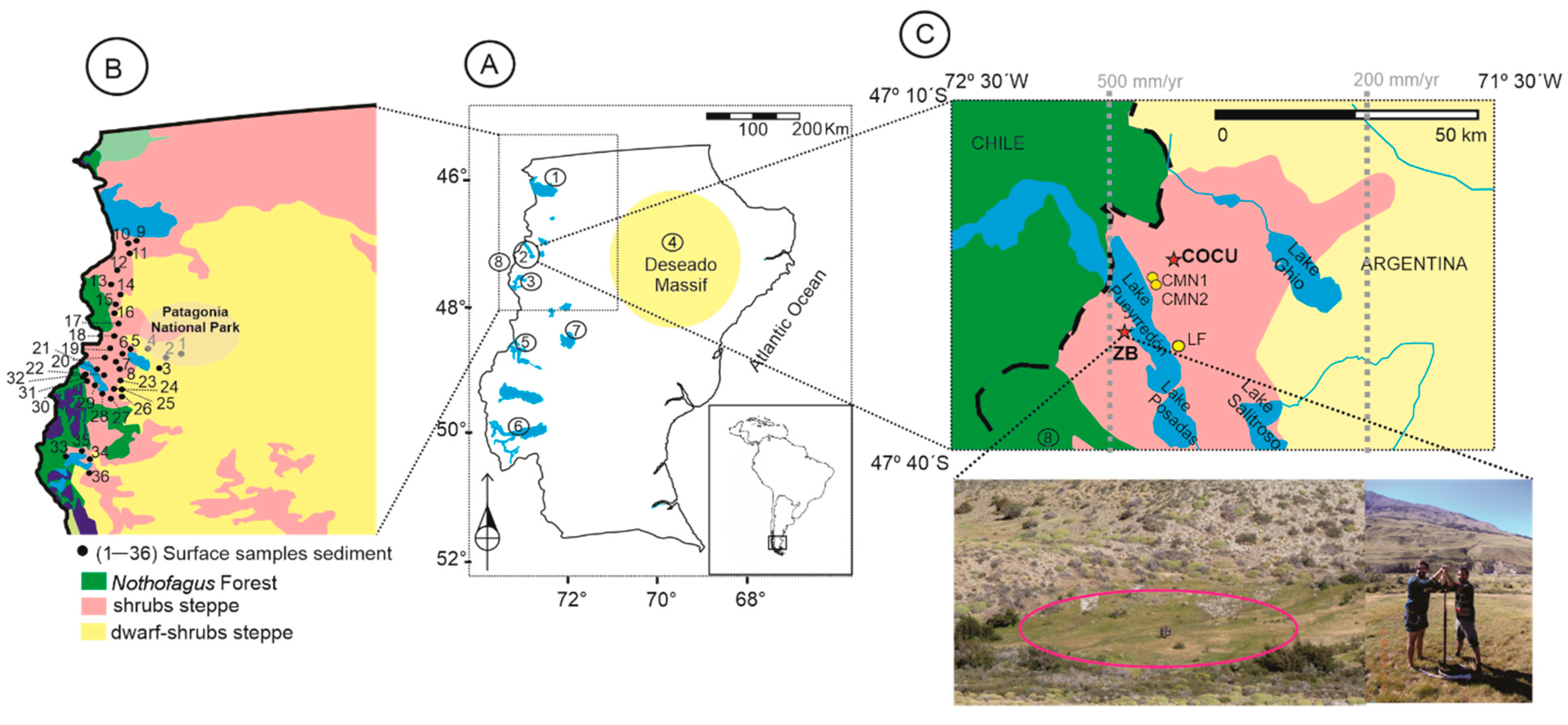
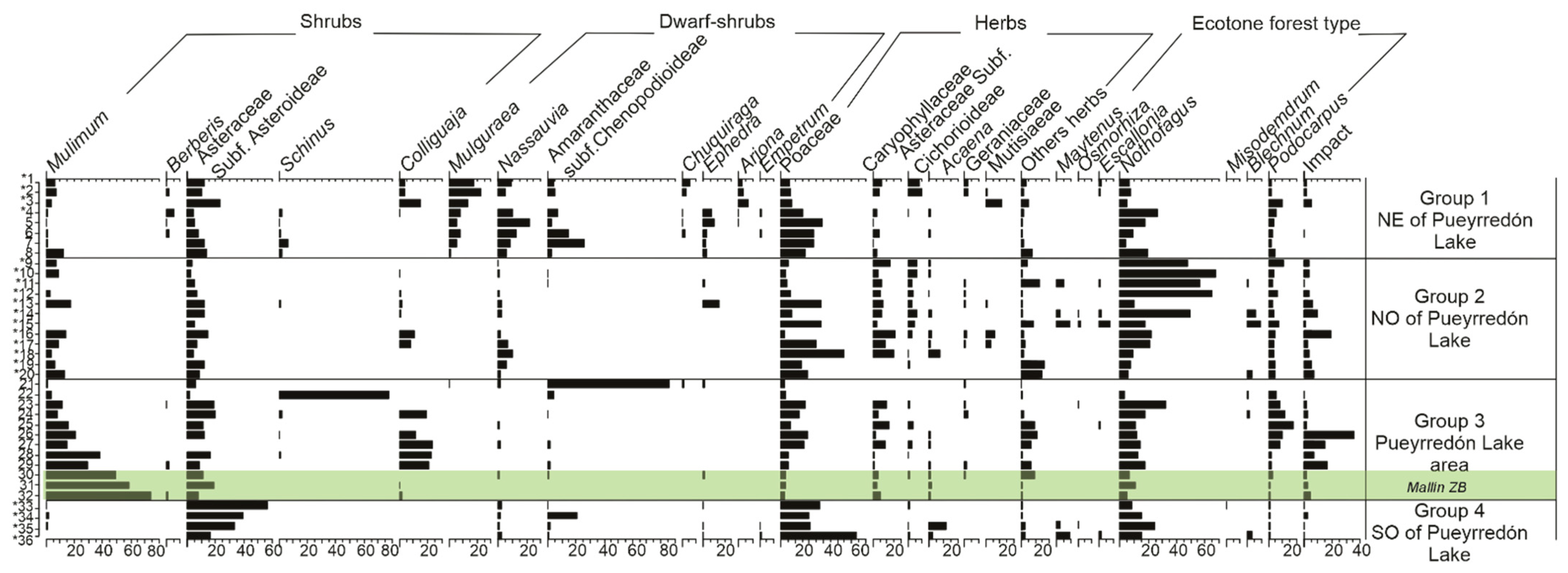
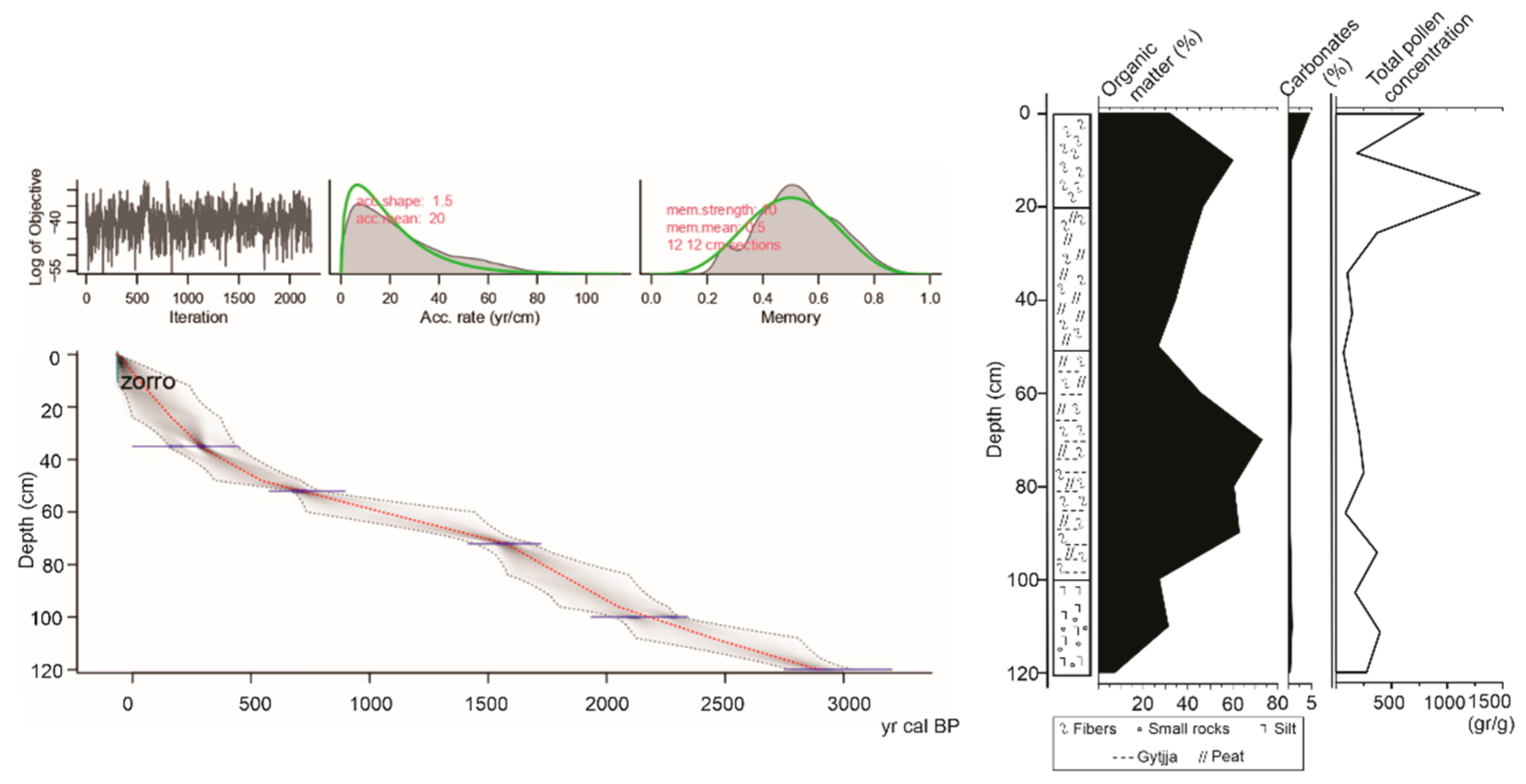
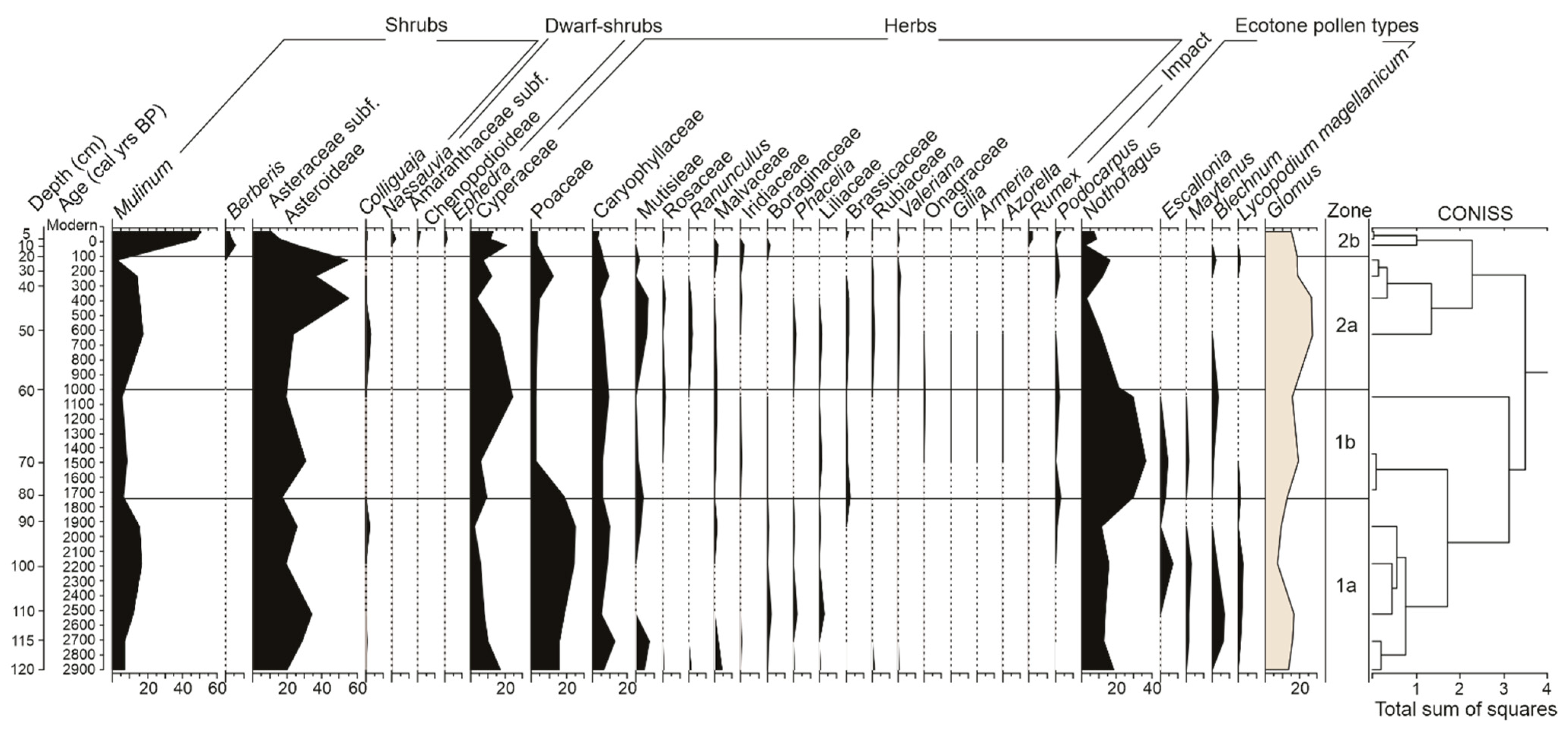
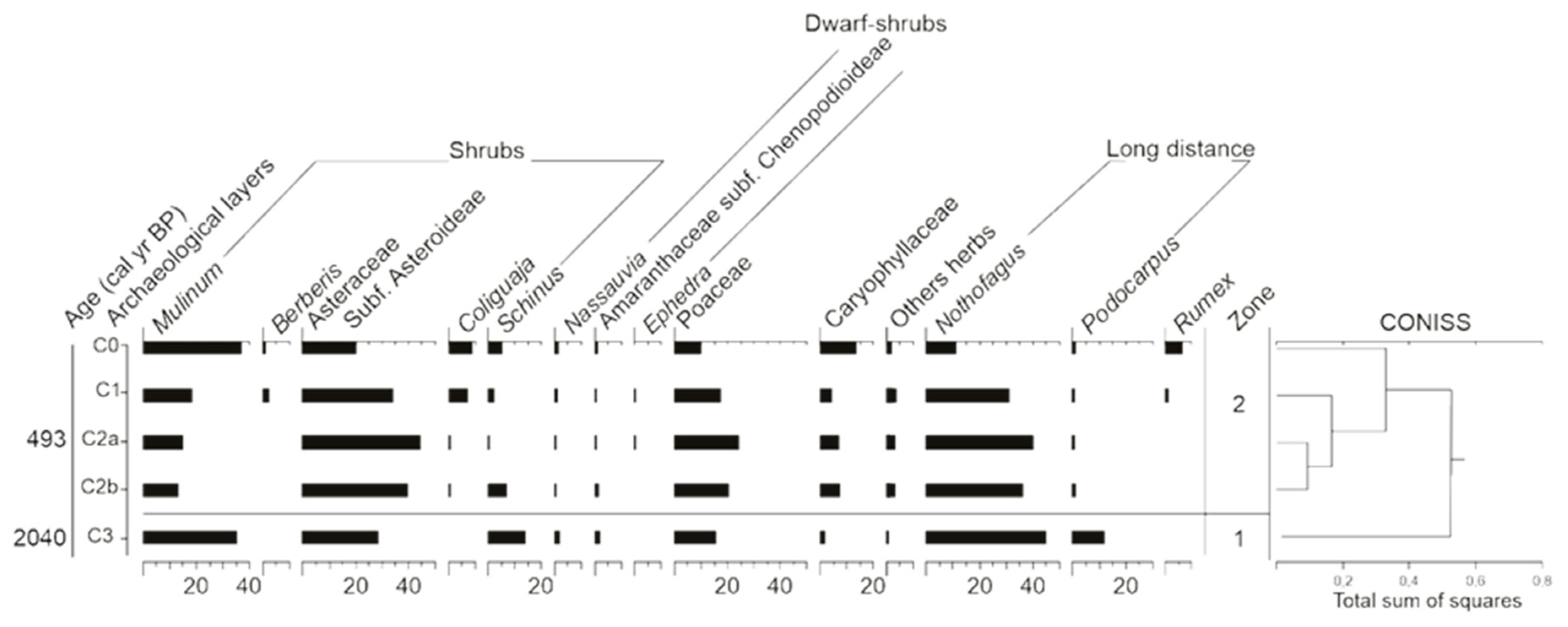

| ZB | ||||
| Code Lab | Depth (cm) | Age 14C | Median Probability (CAL BP) | 2 Range |
| DAMS-028827 | 35 | 264 ± 25 | 277 | 274–315 |
| DAMS-028031 | 51 | 843 ± 23 | 706 | 673–740 |
| DAMS-028032 | 72 | 1722 ± 24 | 1578 | 1532–1614 |
| DAMS-028826 | 100 | 2188 ± 24 | 2123 | 2051–2146 |
| DAMS-014678 | 120 | 2845 ± 29 | 2912 | 2840–3004 |
| COCU | ||||
| Code Lab | Depth (cm) | Age 14C | Median Probability (CAL BP) | 2 Range |
| UGAMS-5883 | Layer 2 | 460 ± 20 | 493 | 451–510 |
| UGAMS-5884 | Layer 3 | 2080 ± 20 | 2040 | 1986–2055 |
Publisher’s Note: MDPI stays neutral with regard to jurisdictional claims in published maps and institutional affiliations. |
© 2022 by the authors. Licensee MDPI, Basel, Switzerland. This article is an open access article distributed under the terms and conditions of the Creative Commons Attribution (CC BY) license (https://creativecommons.org/licenses/by/4.0/).
Share and Cite
Marcos, M.A.; Bamonte, F.P.; Echeverria, M.E.; Sottile, G.D.; Mancini, M.V. Paleoenvironmental Changes for the Last 3000 Cal Years BP in the Pueyrredón Lake Basin, Southern Patagonia, Argentina. Quaternary 2022, 5, 49. https://doi.org/10.3390/quat5040049
Marcos MA, Bamonte FP, Echeverria ME, Sottile GD, Mancini MV. Paleoenvironmental Changes for the Last 3000 Cal Years BP in the Pueyrredón Lake Basin, Southern Patagonia, Argentina. Quaternary. 2022; 5(4):49. https://doi.org/10.3390/quat5040049
Chicago/Turabian StyleMarcos, Maria A., Florencia P. Bamonte, Marcos E. Echeverria, Gonzalo D. Sottile, and Maria V. Mancini. 2022. "Paleoenvironmental Changes for the Last 3000 Cal Years BP in the Pueyrredón Lake Basin, Southern Patagonia, Argentina" Quaternary 5, no. 4: 49. https://doi.org/10.3390/quat5040049
APA StyleMarcos, M. A., Bamonte, F. P., Echeverria, M. E., Sottile, G. D., & Mancini, M. V. (2022). Paleoenvironmental Changes for the Last 3000 Cal Years BP in the Pueyrredón Lake Basin, Southern Patagonia, Argentina. Quaternary, 5(4), 49. https://doi.org/10.3390/quat5040049





